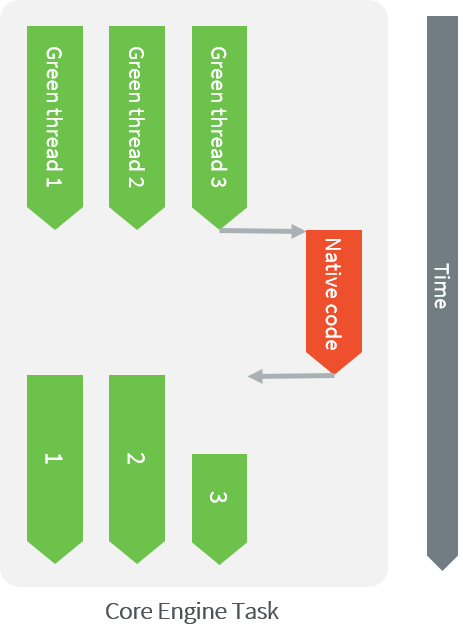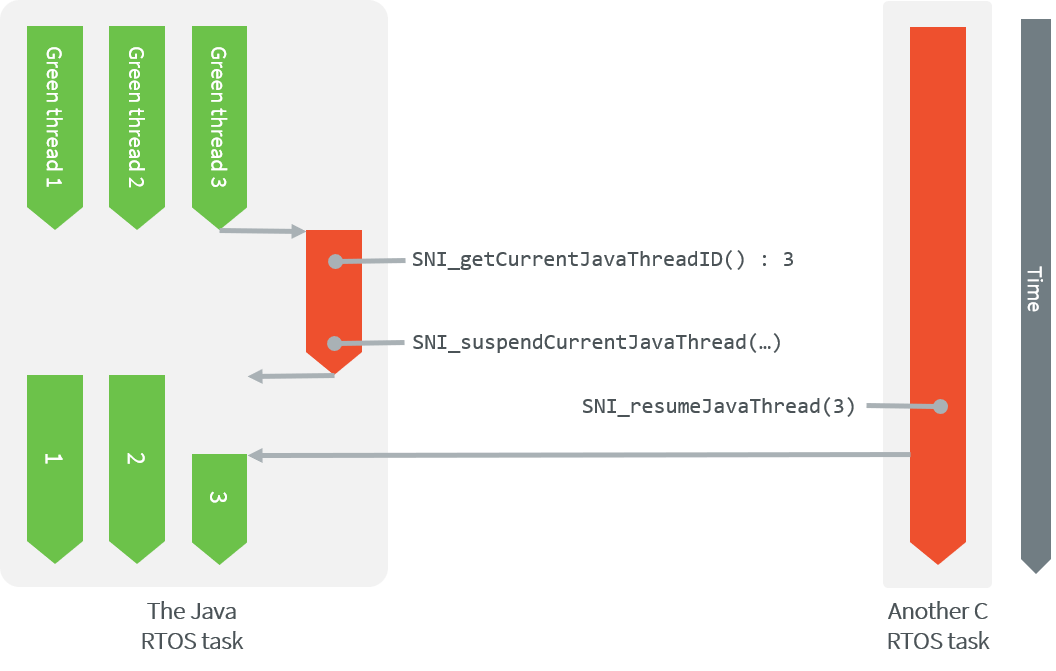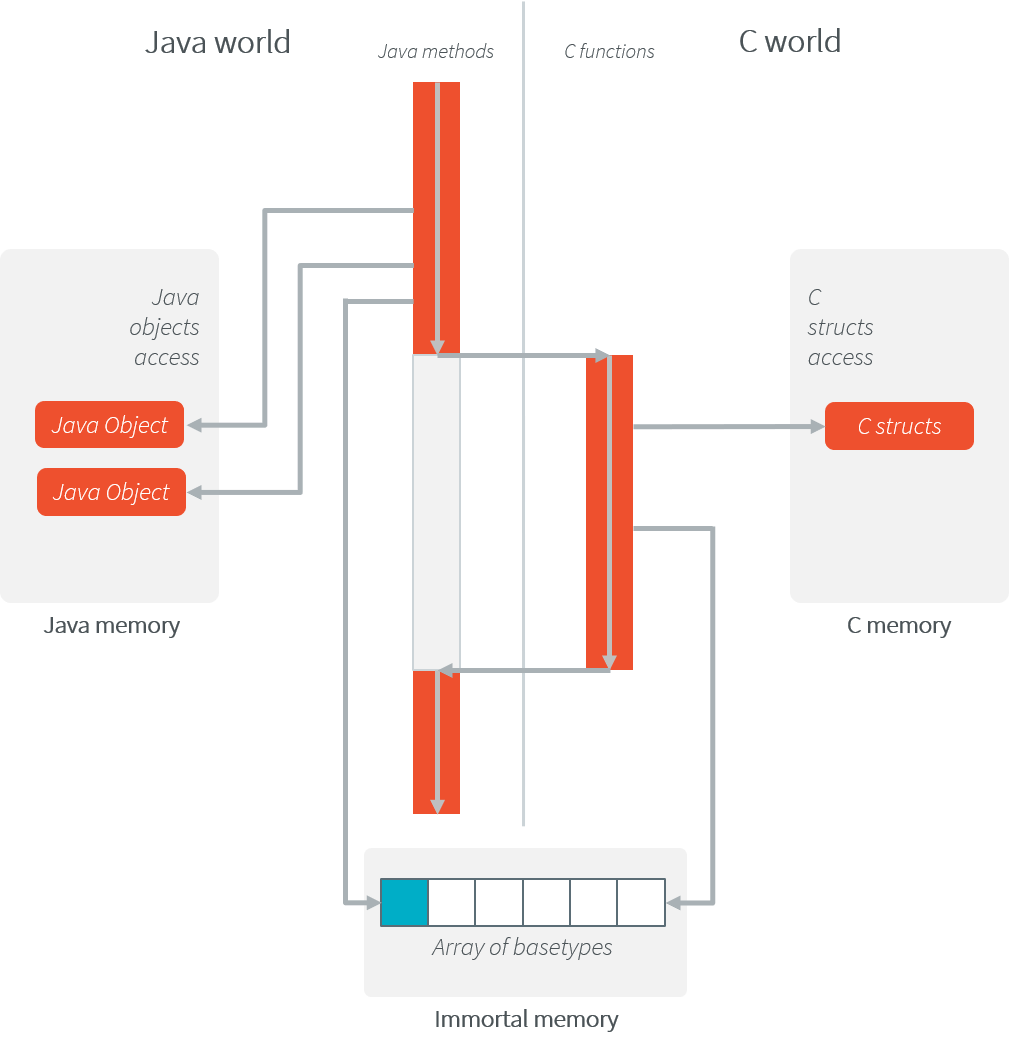Simple Native Interface Specification (SNI)
Introduction
The Simple Native Interface specification (SNI) defines how to cross the barrier between the Managed world and the native world:
Call a C function from Java code.
Pass parameters to the C function.
Return a value from the C world to the Managed world.
Manipulate (read & write) shared memory both in Java and C code: the immortal space.
Note
In the following explanations, the term task refers to native tasks scheduled by the underlying OS or RTOS, while thread refers to MicroEJ threads scheduled by the Core Engine.
Specification Summary
Java APIs |
|
Latest Version |
1.4 |
Module Dependency |
implementation("ej.api:sni:1.4.3")
<dependency org="ej.api" name="sni" rev="1.4.3" />
|
Module Location |
First Example
This first example shows how to declare and implement a Java native
method using SNI. First the method has to be declared native in Java code:
this states that the method is written in another language.
package example;
import java.io.IOException;
/**
* Abstract class providing a native method to access sensor value.
* This method will be executed out of the Core Engine.
*/
public abstract class Sensor {
public static final int ERROR = -1;
public int getValue() throws IOException {
int sensorID = getSensorID();
int value = getSensorValue(sensorID);
if (value == ERROR) {
throw new IOException("Unsupported sensor");
}
return value;
}
protected abstract int getSensorID();
public static native int getSensorValue(int sensorID);
}
class Potentiometer extends Sensor {
protected int getSensorID() {
return Constants.POTENTIOMETER_ID; // POTENTIOMETER_ID is a static final
}
}
Then, the implementation of the method is written in C language.
// File providing an implementation of native method using a C function
#include <sni.h>
#include <potentiometer.h>
#define SENSOR_ERROR (-1)
#define POTENTIOMETER_ID (3)
jint Java_example_Sensor_getSensorValue(jint sensor_id){
if (sensor_id == POTENTIOMETER_ID)
{
return get_potentiometer_value();
}
return SENSOR_ERROR;
}
Java code and C Execution Sequence
Calling C from Java
When a Java native method executes, it executes its C counterpart function. This is done using the CPU budget of the task that has started the Core Engine. While the C function executes, no other Java methods executes and the Core Engine cannot schedule other threads. The Managed world “waits” for the C function to finish.
The following illustration shows the execution a the Core Engine task.
Green thread 3 has called a native method that executes in C.
All Java activities is suspended until the C execution has finished.

Execution of Threads by the Core Engine Task
Synchronization
SNI defines C functions that provide controls for the threads activities:
int32_t SNI_suspendCurrentJavaThread(int64_t timeout): Suspends the execution of the thread that initiated the current C call. This function does not block the C execution. The suspension is effective only at the end of the native method call (when the C call returns). The thread is suspended until either an task callsSNI_resumeJavaThread, or the specified number of milliseconds has elapsed.int32_t SNI_getCurrentJavaThreadID(void): Permits retrieval of the ID of the current thread within the C function (assuming it is a “native Java to C call”). This ID must be given to theSNI_resumeJavaThreadfunction in order to resume execution of the thread.int32_t SNI_resumeJavaThread(int32_t id): Resumes the thread with the given ID. If the thread is not suspended, the resume stays pending.
The following illustration shows Green thread 3 which has called
a native method that executes in C. The C code suspends the thread after
having provisioned its ID (e.g. 3). Another task may later resume the thread.

Green Threads and Task Synchronization
Java And Native Separation
The following illustration shows both Java code and C code accesses to shared objects in the immortal space, while also accessing their respective memory. In C code, non-immortal arrays can only be accessed within the local scope of a native function.

Java code and C shared objects
Managed World to C World
C Function Call From Managed World
The SNI specification allows the invocation of methods from Java to C: these
methods must be declared static native methods, and the parameters must be
base types or array of base types.
These native methods are used in Java code as standard Java methods.
Example:
package example;
public class Foo{
public void bar(){
int times = 3;
print(times);
}
public static native void print(int times);
}
#include <sni.h>
#include <stdio.h>
void Java_example_Foo_print(jint times){
while (--times >= 0){
printf("Hello world!\n");
}
}
Java Types And C Types
Base Types
Types may have different representations depending on the language. The
file sni.h defines the C types that represent exactly the Java types.
Java Type |
Specification |
C type |
|---|---|---|
void |
No returned type |
|
boolean |
unsigned 8 bits |
|
byte |
signed 8 bits |
|
char |
unsigned 16 bits |
|
short |
signed 16 bits |
|
int |
signed 32 bits |
|
long |
signed 64 bits |
|
float |
IEEE 754 single precision 32 bits |
|
double |
IEEE 754 double precision 64 bits |
|
Java Array
The Java arrays (of base types) are represented in C functions as C arrays: the array is a pointer on the first element of the array, all the elements in line within the memory.
SNI allows to get a Java array length in a C function.
int32_t SNI_getArrayLength(void* array);
Strings
Strings are typically represented quite differently between C & Java code.
In C, strings are represented with C char (8-bit) array with a
'\0' as last character. In Java code, strings are jchar (16-bit) array, not
terminated by '\0'.
To help with the conversion, the SNI Java API provides utility methods to convert between the two representations.
Example:
package example;
public class Foo {
private static final int MAX_STRING_SIZE = 42; // including the '\0' character
public void pushString(String str) {
pushString(SNI.toCString(str));
}
public String pullString() {
byte[] buffer = new byte[MAX_STRING_SIZE];
pullString(buffer);
return SNI.toJavaString(buffer);
}
private static native void pushString(byte[] str);
private static native void pullString(byte[] buffer);
}
#include <sni.h>
#include <string.h>
#define MAX_STRING_SIZE 42
static char gStr[MAX_STRING_SIZE];
void Java_example_Foo_pushString(jbyte *str) {
strncpy(gStr, (char*) str, MAX_STRING_SIZE);
}
void Java_example_Foo_pullString(jbyte *buffer) {
strncpy((char*) buffer, gStr, MAX_STRING_SIZE);
}
Note
The string conversions use the default platform encoding. To use a different encoding, refer to the String API.
Naming Convention
SNI uses a naming convention to name-match the Java native method with its C counterpart function.
The C function name is the concatenation of the following components:
the prefix “
Java_”.the package name of the class, each sub packages is separated with “
_”.the separator “
_”.the class name.
the separator “
_”.the method name.
If the method is overloaded by another method, native or not (the two methods have the same name with different arguments), the function name must be followed by the arguments descriptor, obtained with the following components (except if the method has no arguments):
the separator “
__” (two underscores)the name of each argument type, without separator, preceded by “
_3“ if it is an array.
The following table gives the descriptors of the Java types for arguments.
Java type |
SNI name |
|---|---|
boolean |
Z |
byte |
B |
char |
C |
short |
S |
int |
I |
long |
J |
float |
F |
double |
D |
The character underscore (“_”) is used as a separator in the
name. If this character is used within the Java name (either in package,
class name or method name), it is replaced with “_1”. Because the
Java names cannot start with a number, the characters “_1” cannot
be confused with separator character.
Examples of Java native methods and their counterpart C functions:
package example.sni.impl;
class Hello {
public static native void nativ01(int i);
public static native void nativ02(boolean b, int[] i);
public static native void nativ_03();
public static native void nativ04();
public static native void nativ04(long l, double d);
public static native void nativ04(int[] ia, int ib, char[] ca);
}
void Java_example_sni_impl_Hello_nativ01( jint i);
void Java_example_sni_impl_Hello_nativ02( jboolean b, jint* i);
void Java_example_sni_impl_Hello_nativ_103();
void Java_example_sni_impl_Hello_nativ04();
void Java_example_sni_impl_Hello_nativ04__JD( jlong l, jdouble d);
void Java_example_sni_impl_Hello_nativ04___3II_3C( jint* ia, jint ib, jchar* ca);
Parameters Constraints
There are strong constraints on arguments given by Java methods to native functions:
Only base types and array of base types are allowed in the parameters. No other objects can be passed: the native functions cannot access Java objects field nor methods.
When base type arrays are passed in parameters, they must have only one dimension. No multi dimension array are allowed (
int[][]is forbidden for example).Only base types are allowed as return type.
This constraints are checked at link-time to ensure that they are respected.
Startup
The Core Engine needs first to be initialized, and then started. It is the programmer responsibility to create a task and to start the Core Engine within this task.
SNI defines C functions to create a Managed world, to start it and to free it:
void SNI_createVM(void): creates and initializes the Core Engine context.int32_t SNI_startVM(void,int32_t,char): starts the Core Engine. This function returns when the Java application ends.int32_t SNI_getExitCode(void vm): gets the Java application exit code, afterSNI_startVMhas successfully returned. This is the value passed by the application to System.exit() method.void SNI_destroyVM(void vm): does nothing if the Core Engine is still running. This function must be called in the task that created the Core Engine.
The following illustration shows a typical example of Core Engine startup code.
void microej_main(int argc, char **argv) {
void* vm;
int core_engine_error_code = -1;
int32_t app_exit_code = 0;
vm = SNI_createVM();
if (vm == NULL) {
printf("MicroEJ initialization error.\n");
} else {
core_engine_error_code = (int)SNI_startVM(vm, argc, argv);
if (core_engine_error_code < 0) {
printf("MicroEJ execution error (err = %d).\n", (int) core_engine_error_code);
} else {
app_exit_code = SNI_getExitCode(vm);
printf("MicroEJ END (exit code = %d)\n", (int) app_exit_code);
}
SNI_destroyVM(vm);
}
}

Comments
Your comments about this specification are welcome. Please contact our support team with “SNI” as subject.